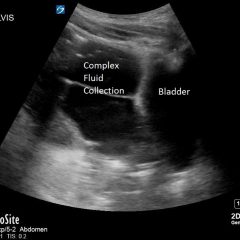Ruptured Abdominal Aortic Aneurysm
History of present illness:
A 69-year-old male with poorly controlled hypertension presented with 1 hour of severe low back pain that radiated to his abdomen. The patient was tachycardic and had an initial blood pressure of 70/40. He had a rigid and severely tender abdomen. The patient’s history of hypertension, abnormal vital signs, severity and location of his pain were suspicious for a ruptured abdominal aortic aneurysm (AAA). Therefore, a computed tomography angiogram (CTA) was ordered.
Significant findings:
The CTA demonstrated a ruptured 7.4 cm infrarenal abdominal aortic aneurysm with a large left retroperitoneal hematoma.
Discussion:
True abdominal aortic aneurysm is defined as at least a 3cm dilatation of all three layers of the arterial wall of the abdominal aorta.1 An estimated 15,000 people die per year in the US of this condition.2 Risk factors for AAA include males older than 65, tobacco use, and hypertension.1,3,4 There are also congenital, mechanical, traumatic, inflammatory, and infectious causes of AAA.3 Rupture is often the first manifestation of the disease. The classic triad of abdominal pain, pulsatile mass, and hypotension is seen in only 50% of ruptured AAAs.5 Pain (abdominal, groin, or back) is the most common symptom. The most common misdiagnoses of ruptured AAAs are renal colic, diverticulitis, and gastrointestinal hemorrhage.6
Bedside ultrasonography is the fastest way to detect this condition and is nearly 100% sensitive.1 One study showed that bedside ultrasounds performed by emergency physicians had a sensitivity of .94 [95% CI = .86-1.0] and specificity of 1 [95% CI = .98-1.0] for detecting AAAs.7 Computed tomography angiography has excellent sensitivity (approximately 100%) and yields the added benefit of facilitating surgical planning and management.1
Without surgical treatment, a ruptured AAA is almost uniformly fatal, and 50% of those who undergo surgery do not survive.1 Early resuscitation and coordination with vascular surgery should be pursued without delay. The concept of permissive hypotension (target systolic blood pressure 90 mmHg) in patients with a ruptured AAA is controversial. Until there are randomized controlled trials supporting patient-centered benefits, such as improved mortality, clinicians should refrain from permissive hypotension.8
Topics:
Abdominal aortic aneurysm, AAA, CT, ultrasound, low back pain, vascular surgery, critical care.
References:
- Bessen HA. Abdominal Aortic Aneurysm. In: Marx JA, Hockberger RS, Walls RM, Adams J, Rosen P, eds. Rosen’s Emergency Medicine: Concepts and Clinical Practice. 7th Philadelphia, PA: Elsevier/Saunders; 2010:1093-1102.
- National Center for Health Statistics. Vital statistics of the United States 1985. Vol. II, mortality, part A. Washington, DC: US Dept of Health and Human Services; 1988. DHHS publication (PHS) 88-1101.
- Johnston KW, Rutherford RB, Tilson MD, Shah DM, Hollier L, Stanley JC. Suggested standards for reporting on arterial aneurysms. J Vasc Surg. 1991;13(3):452-458. doi: 1067/mva.1991.26737
- Blanchard JF, Armenian HK, Friesen PP. Risk factors for abdominal aortic aneurysm: results of a case-control study. Am J Epidemiol. 2000;151(6):575-583.
- Dark SG, Eadie DD. Abdominal aortic aneurysmectomy: a review of 60 consecutive cases contrasting elective and emergency surgery. J Cardiovasc Surg. 1973;14:484-491.
- Marston WA, Ahlquist R, Johnson G, et al. Misdiagnosis of ruptured abdominal aortic aneurysms. J Vasc Surg. 1992;16:17-22. doi: 10.1016/S0196-0644(05)80086-1
- Costantino TG, Bruno EC, Handly N, Dean AJ. Accuracy of emergency medicine ultrasound in the evaluation of abdominal aortic aneurysm. J Emerg Med. 2005;29(4):455-460. doi: 10.1016/j.jemermed.2005.02.016
- Moreno DH, Cacione DG, Baptista-Silva JC. Controlled hypotension versus normotensive resuscitation strategy for people with ruptured abdominal aortic aneurysm. Cochrane Database Syst Rev. 2016;(5):CD011664. doi: 10.1002/14651858.CD011664.pub2






